temazepam
FULL PRESCRIBING INFORMATION: CONTENTS*
- TEMAZEPAM DESCRIPTION
- CLINICAL PHARMACOLOGY
- TEMAZEPAM INDICATIONS AND USAGE
- TEMAZEPAM CONTRAINDICATIONS
- WARNINGS
- PRECAUTIONS
- TEMAZEPAM ADVERSE REACTIONS
- DRUG ABUSE AND DEPENDENCE
- OVERDOSAGE
- TEMAZEPAM DOSAGE AND ADMINISTRATION
- HOW SUPPLIED
- MEDICATION GUIDE
FULL PRESCRIBING INFORMATION
 Rx only
Rx onlyTEMAZEPAM DESCRIPTION
H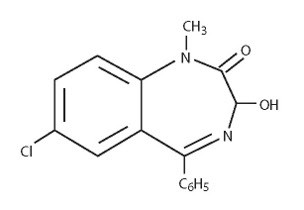 161322
1613227.5 mg, 15 mg, 22.5 mg and 30 mg Capsules
7.5 mg Capsules
Inactive Ingredients:
May also include:
15 mg Capsules
Inactive Ingredients:
May also include:
22.5 mg Capsules
Inactive Ingredients:
May also include:
30 mg Capsules
Inactive Ingredients:
May also include:
CLINICAL PHARMACOLOGY
Pharmacokinetics
In a single and multiple dose absorption, distribution, metabolism, and excretion (ADME) study, using 3H labeled drug, temazepam was well absorbed and found to have minimal (8%) first pass metabolism. There were no active metabolites formed and the only significant metabolite present in blood was the O-conjugate. The unchanged drug was 96% bound to plasma proteins. The blood level decline of the parent drug was biphasic with the short half-life ranging from 0.4 to 0.6 hours and the terminal half-life from 3.5 to 18.4 hours (mean 8.8 hours), depending on the study population and method of determination. Metabolites were formed with a half-life of 10 hours and excreted with a half-life of approximately 2 hours. Thus, formation of the major metabolite is the rate limiting step in the biodisposition of temazepam. There is no accumulation of metabolites. A dose-proportional relationship has been established for the area under the plasma concentration/time curve over the 15 to 30 mg dose range.
Temazepam
was completely metabolized through conjugation prior to excretion; 80% to 90% of the
dose appeared in the urine. The major metabolite was the O-conjugate of temazepam (90%);
the O-conjugate of N-desmethyl temazepam was a minor metabolite (7%).
Bioavailability, Induction, and Plasma
Levels
Following ingestion of a 30 mg temazepam capsule, measurable
plasma concentrations were achieved 10 to 20 minutes after dosing with peak plasma
levels ranging from 666 to 982 ng/mL (mean 865 ng/mL) occurring approximately 1.2 to 1.6
hours (mean 1.5 hours) after dosing.
In a 7 day study, in which subjects were
given a 30 mg temazepam capsule 1 hour before retiring, steady-state (as measured by the
attainment of maximal trough concentrations) was achieved by the third dose. Mean plasma
levels of temazepam (for days 2 to 7) were 260±210 ng/mL at 9 hours and 75±80 ng/mL at
24 hours after dosing. A slight trend toward declining 24 hour plasma levels was seen
after day 4 in the study, however, the 24 hour plasma levels were quite
variable.
At a dose of 30 mg once-a-day for 8 weeks, no evidence of enzyme
induction was found in man.
Elimination Rate of
Benzodiazepine Hypnotics and Profile of Common Untoward Effects
The type and duration of hypnotic effects and the profile of unwanted effects during administration of benzodiazepine hypnotics may be influenced by the biologic half-life of the administered drug and for some hypnotics, the half-life of any active metabolites formed. Benzodiazepine hypnotics have a spectrum of half-lives from short (<4 hours) to long (>20 hours). When half-lives are long, drug (and for some drugs their active metabolites) may accumulate during periods of nightly administration and be associated with impairments of cognitive and/or motor performance during waking hours; the possibility of interaction with other psychoactive drugs or alcohol will be enhanced. In contrast, if half-lives are shorter, drug (and, where appropriate, its active metabolites) will be cleared before the next dose is ingested, and carry-over effects related to excessive sedation or CNS depression should be minimal or absent. However, during nightly use for an extended period, pharmacodynamic tolerance or adaptation to some effects of benzodiazepine hypnotics may develop. If the drug has a short elimination half-life, it is possible that a relative deficiency of the drug, or, if appropriate, its active metabolites (i.e., in relationship to the receptor site) may occur at some point in the interval between each night's use. This sequence of events may account for 2 clinical findings reported to occur after several weeks of nightly use of rapidly eliminated benzodiazepine hypnotics, namely, increased wakefulness during the last third of the night, and the appearance of increased signs of daytime
anxiety.
Controlled Trials Supporting
Efficacy
Temazepam improved sleep parameters in clinical studies.
Residual medication effects ("hangover") were essentially absent. Early morning
awakening, a particular problem in the geriatric patient, was significantly
reduced.
Patients with chronic insomnia were evaluated in 2 week, placebo controlled sleep laboratory studies with temazepam at doses of 7.5 mg, 15 mg, and 30 mg, given 30 minutes prior to bedtime. There was a linear dose-response improvement in total sleep time and sleep latency, with significant drug-placebo differences at 2 weeks occurring only for total sleep time at the 2 higher doses, and for sleep latency only at the highest dose.
In these sleep laboratory studies, REM sleep was essentially unchanged and slow wave sleep was decreased. No measurable effects on daytime alertness or performance occurred following temazepam treatment or during the withdrawal period, even though a transient sleep disturbance in some sleep parameters was observed following withdrawal of the higher doses. There was no evidence of tolerance development in the sleep laboratory parameters when patients were given temazepam nightly for at least 2 weeks.
In addition, normal subjects with transient insomnia associated with first night adaptation to the sleep laboratory were evaluated in 24 hour, placebo controlled sleep laboratory studies with temazepam at doses of 7.5 mg, 15 mg, and 30 mg, given 30 minutes prior to bedtime. There was a linear dose-response improvement in total sleep time, sleep latency and number of awakenings, with significant drug-placebo differences occurring for sleep latency at all doses, for total sleep time at the 2 higher doses and for number of awakenings only at the 30 mg dose.
TEMAZEPAM INDICATIONS AND USAGE
Temazepam Capsules, USP are indicated for the short-term treatment of insomnia (generally 7 to 10 days).
For patients with short-term insomnia, instructions in the prescription should indicate that Temazepam Capsules, USP should be used for short periods of time (7 to 10 days).
The clinical trials performed in support of efficacy were 2 weeks in duration with the final formal assessment of sleep latency performed at the end of treatment.
TEMAZEPAM CONTRAINDICATIONS
Benzodiazepines may cause fetal harm when administered to a pregnant woman. An increased risk of congenital malformations associated with the use of diazepam and chlordiazepoxide during the first trimester of pregnancy has been suggested in several studies. Transplacental distribution has resulted in neonatal CNS depression following the ingestion of therapeutic doses of a benzodiazepine hypnotic during the last weeks of pregnancy.
Reproduction studies in animals with temazepam were performed in rats and rabbits. In a perinatal-postnatal study in rats, oral doses of 60 mg/kg/day resulted in increasing nursling mortality. Teratology studies in rats demonstrated increased fetal resorptions at doses of 30 and 120 mg/kg in one study and increased occurrence of rudimentary ribs, which are considered skeletal variants, in a second study at doses of 240 mg/kg or higher. In rabbits, occasional abnormalities such as exencephaly and fusion or asymmetry of ribs were reported without dose relationship. Although these abnormalities were not found in the concurrent control group, they have been reported to occur randomly in historical controls. At doses of 40 mg/kg or higher, there was an increased incidence of the 13th rib variant when compared to the incidence in concurrent and historical controls.
Temazepam is contraindicated in women who are or may become pregnant. If this drug is used during pregnancy, or if the patient becomes pregnant while taking this drug, the patient should be apprised of the potential hazard to the fetus. Patients should be instructed to discontinue the drug prior to becoming pregnant. The possibility that a woman of childbearing potential may be pregnant at the time of institution of therapy should be considered.
WARNINGS
Sleep disturbance may be the presenting manifestation of an underlying physical and/or psychiatric disorder. Consequently, a decision to initiate symptomatic treatment of insomnia should only be made after the patient has been carefully evaluated. The failure of insomnia to remit after 7 to 10 days of treatment may indicate the presence of a primary psychiatric and/or medical illness that should be evaluated. Worsening of insomnia may be the consequence of an unrecognized psychiatric or physical disorder as may the emergence of new abnormalities of thinking or behavior. Such abnormalities have also been reported to occur in association with the use of drugs with central nervous system depressant activity, including those of the benzodiazepine class. Because some of the worrisome adverse effects of benzodiazepines, including temazepam, appear to be dose related (see
PRECAUTIONS
and
DOSAGE AND ADMINISTRATION
), it is important to use the lowest possible effective dose. Elderly patients are especially at risk.
Some of these changes may be characterized by decreased inhibition, e.g., aggressiveness and extroversion that seem out of character, similar to that seen with alcohol. Other kinds of behavioral changes can also occur, for example, bizarre behavior, agitation, hallucinations, and depersonalization. Complex behaviors such as "sleep-driving" (i.e., driving while not fully awake after ingestion of a sedative-hypnotic, with amnesia for the event) have been reported. These events can occur in sedative-hypnotic-naïve as well as in sedative-hypnotic-experienced persons. Although behaviors such as sleep-driving may occur with temazepam alone at therapeutic doses, the use of alcohol and other CNS depressants with temazepam appears to increase the risk of such behaviors, as does the use of temazepam at doses exceeding the maximum recommended dose. Due to the risk to the patient and the community, discontinuation of temazepam should be strongly considered for patients who report a "sleep-driving" episode. Other complex behaviors (e.g., preparing and eating food, making phone calls, or having sex) have been reported in patients who are not fully awake after taking a sedative-hypnotic. As with sleep-driving, patients usually do not remember these events. Amnesia and other neuro-psychiatric symptoms may occur unpredictably. In primarily depressed patients, worsening of depression, including suicidal thinking has been reported in association with the use of
sedative/hypnotics.
It can rarely be determined with certainty whether a particular instance of the abnormal behaviors listed above is drug induced, spontaneous in origin, or a result of an underlying psychiatric or physical disorder. Nonetheless, the emergence of any new behavioral sign or symptom of concern requires careful and immediate evaluation.
Withdrawal symptoms (of the barbiturate type) have occurred after the abrupt discontinuation of benzodiazepines (see
DRUG ABUSE AND DEPENDENCE
).
Severe Anaphylactic and Anaphylactoid Reactions
Rare cases of angioedema involving the tongue, glottis or larynx have been reported in patients after taking the first or subsequent doses of sedative-hypnotics, including temazepam. Some patients have had additional symptoms such as dyspnea, throat closing, or nausea and vomiting that suggest anaphylaxis. Some patients have required medical therapy in the emergency department. If angioedema involves the tongue, glottis or larynx, airway obstruction may occur and be fatal.
Patients who develop angioedema after treatment with temazepam should not be rechallenged with the drug.
PRECAUTIONS
General
Since the risk of the development of oversedation, dizziness, confusion, and/or ataxia increases substantially with larger doses of benzodiazepines in elderly and debilitated patients, 7.5 mg of temazepam is recommended as the initial dosage for such patients.
Temazepam should be administered with caution in severely depressed patients or those in whom there is any evidence of latent depression; it should be recognized that suicidal tendencies may be present and protective measures may be necessary.
The usual precautions should be observed in patients with impaired renal or hepatic function and in patients with chronic pulmonary insufficiency.
If temazepam is to be combined with other drugs having known hypnotic properties or CNS-depressant effects, consideration should be given to potential additive effects.
The possibility of a synergistic effect exists with the co-administration of temazepam and diphenhydramine. One case of stillbirth at term has been reported 8 hours after a pregnant patient received temazepam and diphenhydramine. A cause and effect relationship has not yet been determined (see
CONTRAINDICATIONS
).
Special Concerns
"Sleep-Driving" and Other Complex Behaviors -see WARNINGS Laboratory Test
Drug Interactions
Carcinogenesis, Mutagenesis, Impairment of Fertility
Pregnancy
see CONTRAINDICATIONS Nursing Mothers
Pediatric Use
Geriatric Use
TEMAZEPAM ADVERSE REACTIONS
During controlled clinical studies in which 1076 patients received temazepam at bedtime, the drug was well tolerated. Side effects were usually mild and transient. Adverse reactions occurring in 1% or more of patients are presented in the following table:
|
|
Temazepam % Incidence (n=1076) |
Placebo % Incidence (n=783) |
| Drowsiness | 9.1 | 5.6 |
| Headache | 8.5 | 9.1 |
| Fatigue | 4.8 | 4.7 |
| Nervousness | 4.6 | 8.2 |
| Lethargy | 4.5 | 3.4 |
| Dizziness | 4.5 | 3.3 |
| Nausea | 3.1 | 3.8 |
| Hangover | 2.5 | 1.1 |
| Anxiety | 2.0 | 1.5 |
| Depression | 1.7 | 1.8 |
| Dry Mouth | 1.7 | 2.2 |
| Diarrhea | 1.7 | 1.1 |
| Abdominal Discomfort | 1.5 | 1.9 |
| Euphoria | 1.5 | 0.4 |
| Weakness | 1.4 | 0.9 |
| Confusion | 1.3 | 0.5 |
| Blurred Vision | 1.3 | 1.3 |
| Nightmares | 1.2 | 1.7 |
| Vertigo | 1.2 | 0.8 |
The following adverse events have been reported less frequently (0.5% to 0.9%):
Central Nervous System - anorexia, ataxia, equilibrium loss, tremor, increased dreaming
Cardiovascular - dyspnea, palpitations
Gastrointestinal – vomiting
Musculoskeletal – backache
Special Senses - hyperhidrosis, burning eyes
Amnesia, hallucinations, horizontal nystagmus, and paradoxical reactions including restlessness, overstimulation and agitation were rare (less than 0.5%).
DRUG ABUSE AND DEPENDENCE
Abuse and addiction are separate and distinct from physical dependence and tolerance. Abuse is characterized by misuse of the drug for non-medical purposes, often in combination with other psychoactive substances. Physical dependence is a state of adaptation that is manifested by a specific withdrawal syndrome that can be produced by abrupt cessation, rapid dose reduction, decreasing blood level of the drug and/or administration of an antagonist. Tolerance is a state of adaptation in which exposure to a drug induces changes that result in a diminution of one or more of the drug's effects over time. Tolerance may occur to both the desired and undesired effects of drugs and may develop at different rates for different effects.
Addiction is a primary, chronic, neurobiological disease with genetic, psychosocial, and environmental factors influencing its development and manifestations. It is characterized by behaviors that include one or more of the following: impaired control over drug use, compulsive use, continued use despite harm, and craving. Drug addiction is a treatable disease, utilizing a multidisciplinary approach, but relapse is common.
Controlled Substance
Temazepam is a controlled substance in Schedule IV.
Abuse and Dependence
Withdrawal symptoms, similar in character to those noted with barbiturates and alcohol (convulsions, tremor, abdominal, and muscle cramps, vomiting, and sweating), have occurred following abrupt discontinuance of benzodiazepines. The more severe withdrawal symptoms have usually been limited to those patients who received excessive doses over an extended period of time. Generally milder withdrawal symptoms (e.g., dysphoria and insomnia) have been reported following abrupt discontinuance of benzodiazepines taken continuously at therapeutic levels for several months. Consequently, after extended therapy at doses higher than 15 mg, abrupt discontinuation should generally be avoided and a gradual dosage tapering schedule followed. As with any hypnotic, caution must be exercised in administering temazepam to individuals known to be addiction-prone or to those whose history suggests they may increase the dosage on their own initiative. It is desirable to limit repeated prescriptions without adequate medical supervision.
OVERDOSAGE
Manifestations of acute overdosage of temazepam can be expected to reflect the CNS effects of the drug and include somnolence, confusion, and coma, with reduced or absent reflexes, respiratory depression, and hypotension. The oral LD50 of temazepam was 1963 mg/kg in mice, 1833 mg/kg in rats, and >2400 mg/kg in rabbits.
Treatment
If the patient is conscious, vomiting should be induced mechanically or with emetics. Gastric lavage should be employed utilizing concurrently a cuffed endotracheal tube if the patient is unconscious to prevent aspiration and pulmonary complications. Maintenance of adequate pulmonary ventilation is essential. The use of pressor agents intravenously may be necessary to combat hypotension. Fluids should be administered intravenously to encourage diuresis. The value of dialysis has not been determined. If excitation occurs, barbiturates should not be used. It should be borne in mind that multiple agents may have been ingested. Flumazenil (Romazicorn®)*, a specific benzodiazepine receptor antagonist, is indicated for the complete or partial reversal of the sedative effects of benzodiazepines and may be used in situations when an overdose with a benzodiazepine is known or suspected. Prior to the administration of flumazenil, necessary measures should be instituted to secure airway, ventilation, and intravenous access. Flumazenil is intended as an adjunct to, not as a substitute for, proper management of benzodiazepine overdose. Patients treated with flumazenil should be monitored for re-sedation, respiratory depression, and other residual benzodiazepine effects for an appropriate period after treatment. The prescriber should be aware of a risk of seizure in association with flumazenil treatment, particularly in long-term benzodiazepine users and in cyclic antidepressant overdose. The complete flumazenil package insert including CONTRAINDICATIONS, WARNINGS, and PRECAUTIONS should be consulted prior to use.
Up-to-date information about the treatment of overdose can often be obtained from a certified Regional Poison Control Center. Telephone numbers of certified Regional Poison Control Centers are listed in the Physicians’ Desk References®**.
TEMAZEPAM DOSAGE AND ADMINISTRATION
While the recommended usual adult dose is 15 mg before retiring, 7.5 mg may be sufficient for some patients, and others may need 30 mg. In transient insomnia, a 7.5 mg dose may be sufficient to improve sleep latency. In elderly or debilitated patients, it is recommended that therapy be initiated with 7.5 mg until individual responses are determined.
HOW SUPPLIED
Temazepam Capsules USP
7.5 mg
Pink opaque cap and white opaque body, imprinted “7.5 mg” on cap and “Novel 120” on the body in black ink.
Bottle of 30..........NDC 67877-148-30
Bottle of 100........NDC 67877-148-01
Bottle of 500........NDC 67877-148-05
15 mg
Blue opaque cap and white opaque body, imprinted “15 mg” on cap and “Novel
121” on the body in black ink.
Bottle of 100........NDC 67877-146-01
Bottle of 500........NDC
67877-146-05
22.5 mg
Light blue opaque cap and white opaque body, imprinted “22.5 mg” on cap and “Novel 122” on the body in black ink.
Bottle of 30..........NDC 67877-149-30
Bottle of 100........NDC 67877-149-01
Bottle of 500........NDC 67877-149-05
30 mg
White opaque cap and body, imprinted “30 mg” on cap and “Novel 123” on the body
in black ink.
Bottle of 100........NDC 67877-147-01
Bottle of 500........NDC
67877-147-05
Dispense in a well-closed, light-resistant container with a child-resistant closure.
Storage: Store at 20° to 25°C (68° to 77°F) [see USP Controlled Room Temperature].
*Romazicon is the registered trademark of Hoffman-LaRoche
Inc.
**Trademark of Medical Economics Company, Inc.
Manufactured by: Distributed
by:
Novel Laboratories, Inc. ASCEND Laboratories,
LLC
Somerset, NJ 08873 Montvale, NJ
07645
MEDICATION GUIDE
TEMAZEPAM Capsules, USP C-IV(temazepam)
What is the most important information I should know about TEMAZEPAM?
After taking TEMAZEPAM, you may get up out of bed while not being fully awake and do an activity that you do not know you are doing. The next morning, you may not remember that you did anything during the night.
Call your doctor right away if you find out that you have done any of the above activities after taking TEMAZEPAM.
Important:
1. Take TEMAZEPAM exactly as prescribed
2. Do not take TEMAZEPAM if you:
What is TEMAZEPAM?
| TEMAZEPAM is a federally controlled substance (C-IV) because it can be abused or lead to dependence. Keep TEMAZEPAM in a safe place to prevent misuse and abuse. Selling or giving away TEMAZEPAM may harm others, and is against the law. Tell your doctor if you have ever abused or been dependent on alcohol, prescription medicines or street drugs. |
Do not take TEMAZEPAM if you are pregnant or planning to become pregnant.
TEMAZEPAM may not be right for you. Before starting TEMAZEPAM, tell your doctor about all of your health conditions, including if you:
Do not take TEMAZEPAM with other medicines that can make you sleepy.
How should I take TEMAZEPAM?
Take TEMAZEPAM right before you get into bed.
Do not take TEMAZEPAM unless you are able to get a full night’s sleep before you must be active again.
Call your doctor if your insomnia worsens or is not better within 7 to 10 days.
What are the possible side effects of TEMAZEPAM?
Possible serious side effects of TEMAZEPAM include:
getting out of bed while not being fully awake and do an activity that you do not know you are doing.
abnormal thoughts and behavior.
memory loss
anxiety
severe allergic reactions.
Call your doctor right away if you have any of the above side effects or any other side effects that worry you while using TEMAZEPAM.
The most common side effects of TEMAZEPAM are:
Do not drive or do other dangerous activities after taking TEMAZEPAM until you feel fully awake.
How should I store TEMAZEPAM?
Keep TEMAZEPAM and all medicines out of reach of children.
General Information about TEMAZEPAM
What are the ingredients in TEMAZEPAM?
7.5mg, 15mg, 22.5mg and 30mg Capsules
7.5 mg Capsules
Inactive Ingredients:
May also include:
15 mg Capsules
Inactive Ingredients:
May also include:
22.5 mg Capsules
Inactive Ingredients:
May also include:
30 mg Capsules
Inactive Ingredients:
May also include:
ASCEND
Laboratories, LLC
NDC 67877-148-01
TEMAZEPAM CIV
Capsules, USP
7.5 mg
PHARMACIST: PLEASE DISPENSE WITH
MEDICATION GUIDE PROVIDED SEPARATELY
Rx only
100 capsules
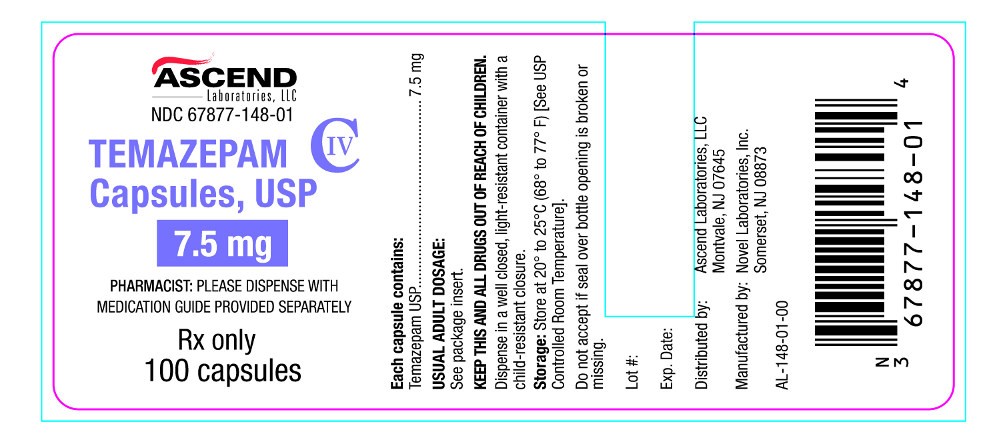
ASCEND
Laboratories, LLC
NDC 67877-146-01
TEMAZEPAM CIV
Capsules, USP
15 mg
Rx only
100 capsules
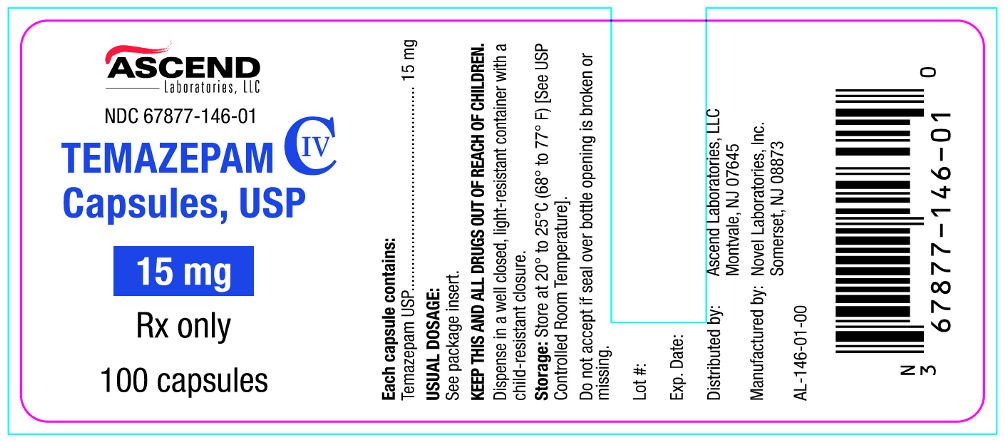
ASCEND
Laboratories, LLC
NDC 67877-149-01
TEMAZEPAM CIV
Capsules, USP
22.5 mg
PHARMACIST: PLEASE DISPENSE WITH
MEDICATION GUIDE PROVIDED SEPARATELY
Rx only
100 capsules
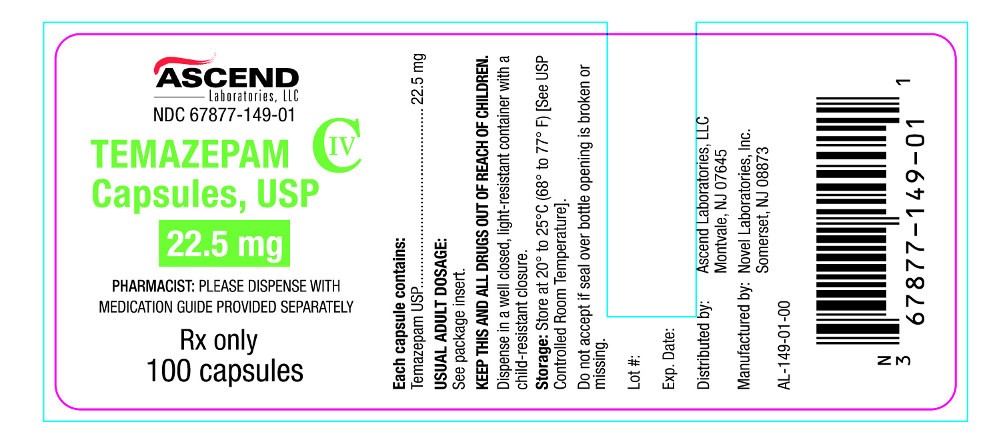
ASCEND
Laboratories, LLC
NDC 67877-147-01
TEMAZEPAM CIV
Capsules, USP
30 mg
Rx only
100 capsules
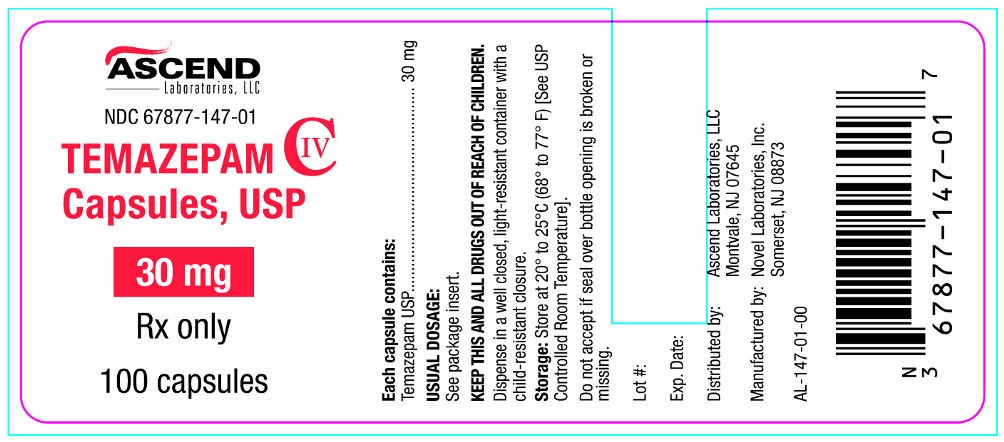
temazepamtemazepam CAPSULE
| ||||||||||||||||||||||||||||||||||||||||||||||||||||||||||||||||||||||||||||||||||||||||||||||||||||||||||
temazepamtemazepam CAPSULE
| ||||||||||||||||||||||||||||||||||||||||||||||||||||||||||||||||||
temazepamtemazepam CAPSULE
| ||||||||||||||||||||||||||||||||||||||||||||||||||||||||||||||||||||||||||||||||||||||||||||||||||||||||||||||
temazepamtemazepam CAPSULE
| |||||||||||||||||||||||||||||||||||||||||||||||||||||||||||||||||||||||||||||||||||||||||||||||||||||